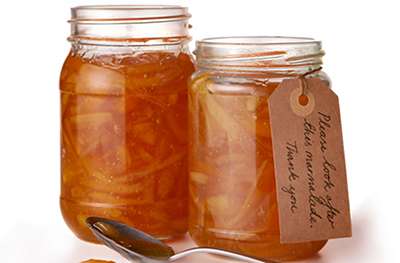0 added
Item price
£1.00Price per unit
£2.21/kg
Please note, we take every care to ensure the product, allergen and recipe information displayed is correct. However, should a product be unavailable, alternatives may be displayed and/or a substitution provided. If you have an allergy or intolerance, please always check the product label before use.
Wash all the fruit thoroughly, then dry in a clean tea towel. Pour 2 litres cold water into a large, wide pan or preserving pan. Cut the oranges and lemon in half, squeeze out the juice and add it to the water. Reserve the pips and orange shells; discard the lemon shell.
Cut the squeezed oranges in half again and, using a metal spoon, scrape the pith and pips into the centre of a large square of muslin. Gather up the edges and tie to form a bag. Add to the pan. Cut the orange peel into strips – chunky for coarse-cut marmalade or thinner for a fine shred. Add to the pan, cover and leave overnight to soften.
The following day, bring the mixture to the boil, then reduce the heat and simmer, uncovered, for 1 hour 30 minutes-2 hours, until the peel is very soft and the liquid has reduced by about half. Remove and discard the muslin bag, squeezing as much liquid as possible back into the pan with the back of a wooden spoon.
Put 2 saucers into the freezer to chill. Add the sugar to the pan; stir over a low heat until dissolved. Turn up the heat and boil rapidly until it reaches setting point – about 15 minutes. To test, remove from the heat and spoon a little onto a chilled plate. Let it cool for a few seconds, then push with a finger. If the surface wrinkles, it’s ready; if not, boil for 5 minutes more and test again. Leave to settle for 15 minutes, then skim off any foam. Stir and pour into warm sterilised jars with a waxed disc or circle of baking parchment on top. Seal when cool, then store in a cool, dark place for up to 3 months. Once open, store in the fridge for up to a month.
Typical values per item when made using specific products in recipe
Energy | 179kJ/ 42kcals |
|---|---|
Fat | 0g |
Saturated Fat | 0g |
Carbohydrates | 10g |
Sugars | 10g |
Fibre | 0.1g |
Protein | 0g |
Salt | 0g |
Book a slot to see product availability at your nearest Waitrose & Partners store
0 added
Item price
£1.00Price per unit
£2.21/kg0 added
Item price
£1.90Price per unit
47.5p each0 added
Item price
£2.20Price per unit
£2.20/kg